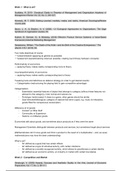Week 1 - What is art?
Suddaby, R. 2010 Construct Clarity in Theories of Management and Organization Academy of
Management Review Vol. 35, No. 3, 346–357.
Kennedy, M. T. 2008. Getting counted: markets, media, and reality. American SociologicalReview
73:270–295.
Baum, J. A., & Shipilov, A. V. (2006). 1.2 Ecological Approaches to Organizations. The Sage
handbook of organization studies, 55.
Kuijken, B. Gemser, G., & Wijnberg, (2016) Effective Product Service Systems: a Value-Based
Framework,Industrial Marketing Management
Deresiewicz, William. "The Death of the Artist—and the Birth of the Creative Entrepreneur." The
Atlantic 315.1 (2015): 92.
Two meta-objectives of course
→ fundamentalism (applying as general as possible)
→ harassment (operationalizing wherever possible, creating real intimacy between concepts)
Performativity of economics
→ applying theory makes reality corresponding more to theory
Counterperformativity of economics
→ applying theory makes reality corresponding less to theory
Tweaking tools and definitions as defence strategy (in order to get desired results)
→ Categorisation (restructuring the playing field to gain competitive advantage)
Categorisation:
- Essentialist: essential features of object that belongs to category (without these features not
allowed to this category), most normal and natural one
- Prototype: family based; if chess is a game, other games should be similar
- Goal-directed/teleological: category of objects that serve a goal, e.g. music for relaxation,
goods fitted for conspicuous consumption
Difference of CI goods:
- Content vs Other Stuff
- Commodity vs Experience
- Hedonic vs Utilitarian goods
Economists talk about goods, and sometimes about products as if they were the same
Management Scientists distinguish between products and services, but sometimes forget about services
(Mathematicians don't know goods and think a product is the result of a multiplication – and, as usual,
mathematicians may have the best understanding)
What is art?
- Art defined as a good that has certain effects
- Art defined as a type of individual activity, with certain intentions
- Art defined as a socially recognized activity, which allows its practitioners a certain identity
- Art defined as an economic activity, an industry or market with certain boundaries
Week 2 - Competition and Market
Ginsburgh, V. (2003) Awards, Success and Aesthetic Quality in the Arts, Journal of Economic
Prspectives, Vol. 17, No. 2, 99-111.
,Hitters, E. & Kamp, M. van der (2010) Tune in, fade out: Music companies and the classification of
domestic music products in the NetherlandsPoetics38, 461–480
Seaman, B. (2004). Competition and the Non-Profit Arts: the Lost Industrial Organization Agenda.
Journal of Cultural Economics, 2004, 28(3), pp. 167-193
Mol, J.M., Wijnberg, N.M. & Carroll, C. (2005) “Value Chain Envy: Explaining New Entry and Vertical
Integration in Popular Music”, Journal of Management Studies, 42, 2, 251-276.
Rindova, V., Becerra, M., & Contrado, I. (2004). Enacting competitive wars: Actions, Language
Games, and Market Consequences. Academy of Management Review, 29, 4, 670-686.
Competition:
- Competitions are in competition with other competitions
- E.g. ballroom dancing: if a competition competes with others, you want to be the most
prestigious with the best dancers and jury etc. (superstar phenomenon)
→ they want, that the people who win it, are successful
Market:
- Where demand and supply meet each other
- What are the boundaries of the market? (can be unclear)
- Different dimension (not only location)
→ spatial – regional, national, global
→ horizontal, vertical
→ temporal – present, past, future
Reality and Perception
- Competition in creative industries is behaving strangely (artist colleagues)
→ some will deny that they are in competition
→ they do not stress their competitive advantage (as they do not regard themselves as
competition)
- Competition is however interchangeable
- Some on the other hand act as if they were in a competition, but are not
→ e.g. subsidiaries (quasi - independent labels)
Week 3 - Organization and Network
Simon, Herbert A. (1991) Organizations and markets, Journal of Economic Perspectives, vol 7, no2,
23-44
Kogut, B (2000) “The Network as Knowledge: generative Rules and the Emergence of Structure”,
Strategic Management journal, Vol. 21, 405-425.
Uzzi, B., and J. Spiro 2005 "Collaboration and creativity: The small world problem." American
Journal of Sociology, 111: 447-504.
Ebbers, J.J. & Wijnberg, N.M. (2009). Latent Organizations in the Film Industry: Contracts, Rewards,
and Resources. Human Relations. 62(7): 987–1009.
Organization
- Sharing the performance by individuals
- Automatically involve networks
Week4 - Strategy and Identity
Ghoshal, Sumantra and Moran, Peter (1996) “Bad for Practice: A Critique of the Transaction Cost
Theory”. Academy of Management Review2
1/1: 13-47.
,Phelan, S.E and Lewin, P (2000) Arriving at a Strategic Theory of the Firm, International Journal of
Management reviews, vol. 2, no 4, 305-323.
Kanter, Rosabeth Moss (2002) “Strategy as Improvisational Theatre”, MIT Sloan Management
Review, Vol 43, no 2, 76-82.
Seong, S., & Godart, F. C. (2018). Influencing the influencers: diversification, semantic strategies, and
creativity evaluations. Academy of Management Journal, 61( 3), 966-993.
Glynn, M.A. and Abzug, R. (2002) “Institutionalizing identity: Symbolic Isomorphism and
Organizational Names” , Academy of Management Journal, vol 45, no.1, 267-280.
Does strategy need a strategy?
Does identity need a strategy?
Strategy:
- Dynamic, changes over time, develops
- Identity: can change over time (but is it useful?)
Week 5 - Innovation and Industry Life Cycle
Suarez, Fernando F., Stine Grodal, and Aleksios Gotsopoulos. (2015) "Perfect timing? Dominant
category, dominant design, and the window of opportunity for firm entry." Strategic Management
Journal 36.3: 437-448.
Kuijken, Bram, Mark AAM Leenders, Nachoem M. Wijnberg, and Gerda Gemser. "The
producer-consumer classification gap and its effects on music festival success." European Journal
of Marketing 50, no. 9/10 (2016): 1726-1745.
Reid, S.E. and De Brentani, U. (2004) “The Fuzzy Front End of New Product Development for
Discontinuous Innovation: A Theoretical Model”, Journal of product innovation Management, Vol. 21,
170-184.
Wijnberg, N.M. (2004) “Innovation and Organization: Value and Competition in Selection Systems”,
Organization Studies, Vol. 25, No. 8, pp. 1469-1490.
Are there categories that clustre consumer preferences that are not predefined?
→ category of consumer and category of genre possible to target the relevant group of consumers
AI is a lot about categorization:
→ supervised learning: cats vs dogs, teach the program to define certain categories
→ basic strength of big data, especially in CI: you can create new categories
Example: Netflix is interested in categories that cluster consumer categories in a way that they don’t
predefine. Extract categories out of raw data, so you can develop particular products in this
particular new category of products you discovered and target the potentially interested consumers
efficiently.
Why category important in regard to innovation?
- Category is the background of any type of evaluation
- Innovativeness is an evaluation, thus needs a categorical background
- Innovativeness on its own is a major component of value
- Paradox: where innovativeness is the most important component, if too much innovativeness
it is difficult to categorize and thus making sense of the innovation
- Even if innovation does not create economic empires, it can diffuse through lots of other
industries (e.g. Mondriaan in fashion and in lots of other industries)
→ argument to support the art – creates new information that can be used by other
industries
, Week 6 - Resource and Capability
Miller, D. and Shamsie, J. (1996) A Resource-Based View of the Firm in two Environments: The
Hollywood Film Studios from 1936 to 1965, Academy of management Journal, Vol. 39, no. 3,
519-543.
Shamsie, J., Martin, X., & Miller, D. (2009). In with the old, in with the new: Capabilities, strategies,
and performance among the Hollywood studios. Strategic Management Journal, 30( 13), 1440-1452.
Arend RJ, Bromiley P. 2009. Assessing the dynamic capabilities view: spare change, everyone?
Strategic Organization 7(1): 75–90.
Mol, J.M. and Wijnberg, N.M. (2011) From Resources to Value and Back: Competition Between and
Within Organizations, British Journal of Management, 22, 1: 77-95.
Boyd, B. K., Bergh, D. D., & Ketchen, D. J. (2010). Reconsidering the reputation—performance
relationship: A resource-based view. Journal of Management, 36(3), 588-609.
Why do some firms outperform others?
RBV: there are many explanations (thus also problematic)
→ everything is possible/“depends”
→ if all assets can be a competitive advantage, how can these resources be studied (if no firm boundaries)
→ many ways to categorize resources
→ paradox: ambiguous concept (tautological/circular definition)
→ if not VRIN, does it mean it is not a resource?
What is “a resource” also depends on:
→ what is the “good” in which value is recognized
→ what/who is the “resource-provider”
→ what is the “organization”
→ what is the “strategy”
→ what is the “competitive process”
Market power explanation
→ Porter: industry structure shapes a firm’s conduct
Efficiency explanation
→ core competencies (competitive advantage): some meet expectations more efficiency than others
Aim of a good strategy?
To help a firm achieve a competitive advantage and to be able to create more economic value using resources
and their capabilities than their competitor.
→ about competitive advantage
→ about value / how to create (more) value
Is RBV failing the test of falsifiability of a theory?
- Helpful framework (but not perfect)
- Main problems with resources:
→ Is RBV claiming to be everything?
→ If everything, definition is unworkable (usefulness of framework is undermined)
→ RBV has no managerial implications
→ RBV only seems to work in predictable (established) markets
→ RBV explains ex post but not ex ante
→ RBV does not explain sequences of assets and how they interact
- Patents not always effective way secure resources





